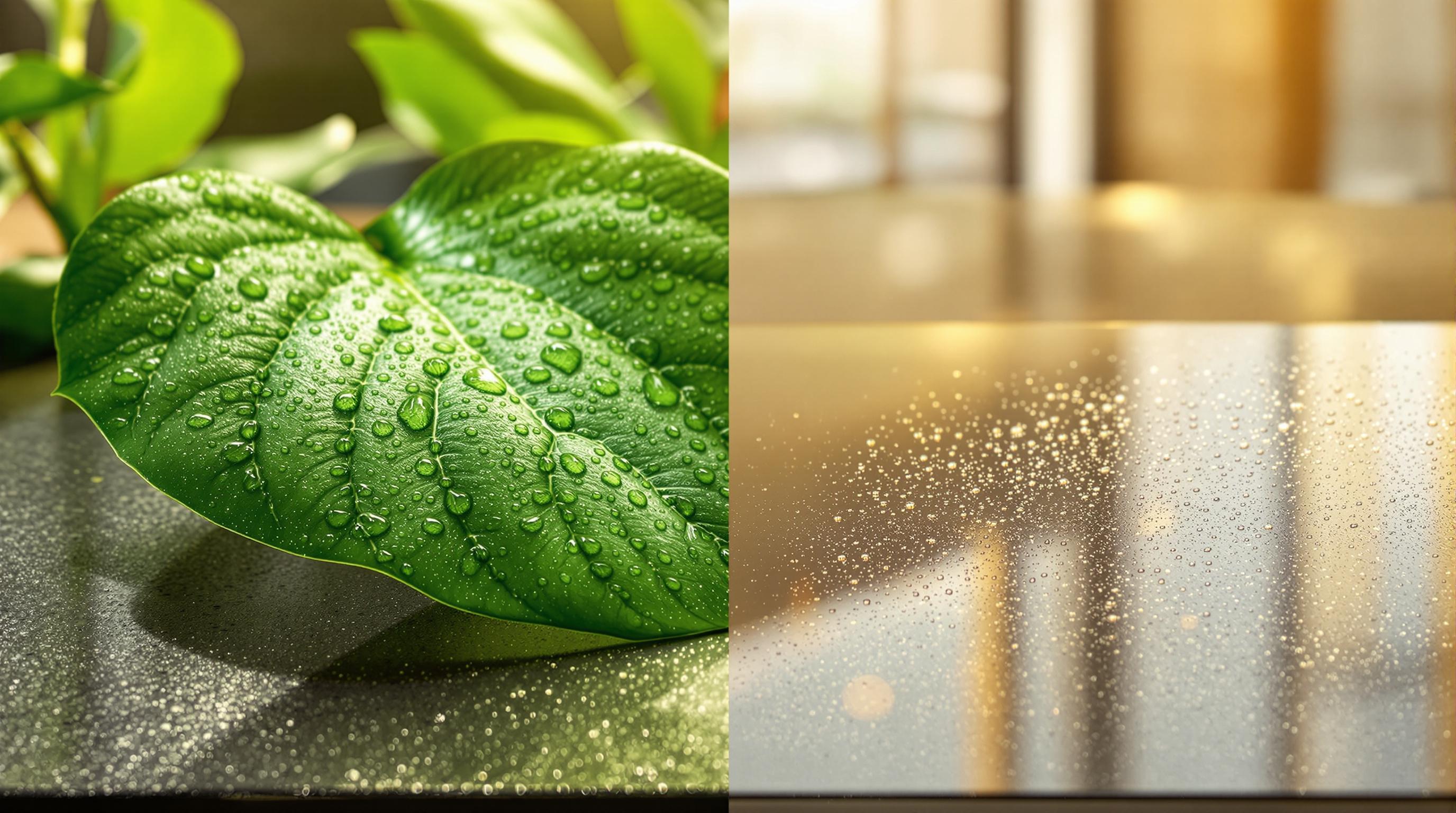Want water-resistant fabrics without risking your health? Many water-repellent textiles rely on PFAS, harmful chemicals linked to health and environmental issues. But safer, PFAS-free options are now available. Here's everything you need to know:
- Why Avoid PFAS? PFAS ("forever chemicals") persist in the environment and are linked to liver damage, thyroid issues, and cancer.
- Top PFAS-Free Alternatives: Silicone-based coatings, nanoparticle treatments, and organic materials like treated cotton or hemp.
- Certifications to Look For: OEKO-TEX Standard 100, GOTS, and bluesign® ensure safety and environmental standards.
- Brands Leading the Way: Patagonia, Fjallraven, and PrAna are already offering PFAS-free options.
- Key Features to Check: Water resistance (measured in mm), breathability (g/m²/24h), and durability.
Quick Comparison of Water Resistance Levels
| HH Rating | Weather Conditions | Best Uses |
|---|---|---|
| 1,500–5,000 mm | Light rain, snow dustings | Casual wear, daily commutes |
| 5,000–10,000 mm | Steady rain, moderate snow | Hiking, camping |
| 10,000–40,000+ mm | Heavy storms, extreme weather | Mountain climbing, winter sports |
Switching to PFAS-free fabrics protects your health and the planet. Keep reading for tips on selecting, caring for, and finding the best water-repellent materials.
Water-Repellent Fabrics and PFAS Basics
Types of Water-Repellent Fabrics
Water-repellent fabrics are designed to make water bead up and roll off, thanks to their specialized surface coatings [1].
Today’s water-resistant textiles come in a variety of options, each tailored to specific needs:
| Fabric Type | Water Resistance | Primary Uses | Key Features |
|---|---|---|---|
| Hi-Count Taslan Nylon | Mid-range | Outdoor wear | Wicking properties, fine filament construction |
| Silkara DWR | Light-medium | Athletic wear | Iridescent look, dual-color threading |
| Micro Suede Polyester | High | Outerwear | Breathable, soft finish, fine fiber weave |
| WeatherMAX 65 | Premium | Marine/Industrial | UV resistant, antimicrobial, 6.5 oz/sq. yard |
Mid-range fabrics generally offer water resistance of about 5,000 mm, paired with a breathability level of roughly 5,000 g/m²/24 hours [4]. Knowing the differences between these fabrics helps you make informed choices about water resistance and safety.
Health and Safety Risks of PFAS
PFAS (per- and polyfluoroalkyl substances) are used to repel water and oil, but they don’t break down easily in the environment or the human body. This persistence is linked to several health concerns [1], including:
- Liver damage
- Thyroid issues
- Reduced fertility
- Developmental delays in children
- Increased cancer risks [1]
"First, the structure of PFAS means they resist breakdown in the environment and in our bodies. Second, they move relatively quickly through the environment, making their contamination hard to contain. Third, for some PFAS, even extremely low levels of exposure can negatively impact our health." - Erik D. Olson, NRDC's senior strategic director of health and food [2]
Current PFAS-Free Options
The textile industry is making strides in creating safer alternatives to PFAS-based treatments. Some of the latest advancements include:
- Silicone-based repellents that provide similar water and stain resistance [7]
- Nanoparticle coatings developed at Harvard, effective even after 65 washes [5]
- Organic options, such as treated hemp or cotton, for natural water repellency [6]
Many manufacturers now include PFAS-free certifications, like GOTS or OEKO-TEX Standard 100, on their products [7]. These advancements show that it’s possible to achieve water repellency without sacrificing safety or environmental care.
Why Fjällräven Doesn't Use GORE-TEX
How to Select Safe Water-Repellent Fabrics
Choosing PFAS-free water-repellent fabrics means paying attention to both performance and safety standards. Here's what to consider.
Understanding Water Resistance Levels
Water resistance is measured using the Hydrostatic Head (HH) rating, which shows how much water pressure a fabric can handle before it leaks. Use the table below to match your needs:
| HH Rating | Weather Conditions | Recommended Uses |
|---|---|---|
| 1,500–5,000 mm | Light rain, snow dustings | Daily commute, casual wear |
| 5,000–10,000 mm | Steady rain, moderate snow | Hiking, camping |
| 10,000–40,000+ mm | Heavy storms, extreme conditions | Mountain climbing, winter sports |
Once you've checked water resistance, consider how breathable the fabric is to ensure comfort during use.
Fabric Breathability
Breathability, measured in g/m²/24h, shows how well moisture escapes from the fabric. This is especially important for comfort during physical activity:
| Breathability Rating | Activity Level | Best For |
|---|---|---|
| 5,000–10,000 g/m² | Low to moderate | Resort activities, urban use |
| 10,000–15,000 g/m² | Active | Backcountry skiing, hiking |
| 15,000–20,000+ g/m² | High intensity | Extended treks, warm climate outings |
For better breathability and durability, consider three-layer fabrics. GORE-TEX is a reliable option for warmth and easy maintenance, while eVent prioritizes breathability but may need more frequent care [10].
Next, ensure the fabric meets safety standards and has proper certifications.
Quality Marks and Testing
To guarantee safety and environmental responsibility, look for certifications like bluesign® and OEKO-TEX.
- bluesign® certification ensures materials meet strict environmental standards. In 2023, bluesign System Partners reported:
- 22% less water used
- 37% lower carbon emissions
- Savings of 6.29 billion liters of water
- Conservation of 773.57 million kilowatt hours of electricity [12]
"Every item carrying a bluesign Product or Approved label has been manufactured to strict safety and environmental requirements." - bluesign Technologies ag [11]
- OEKO-TEX Standard 100 certification tests products against over 1,000 harmful substances. You can verify these certifications using QR codes or certificate numbers on product labels [13].
Lastly, inspect the fabric's construction. Features like sealed or taped seams help prevent leaks [8][9].
sbb-itb-3ba7a4c
PFAS-Free Water Protection Methods
Water-repellent technologies now provide safer alternatives to PFAS-based treatments. Here's a breakdown of some cutting-edge options for protecting against water damage.
Non-Toxic DWR Coatings
Nikwax's Direct.Dry technology stands out for its impressive water resistance performance:
| Performance Metric | Direct.Dry Rating | Industry Standard |
|---|---|---|
| Initial spray test | 100/100 | 80/100 |
| After 5 washes | 100/100 | 70/100 |
| After 20 washes | 80/100 | 60/100 |
"Nikwax Direct.Dry enables us to offer our customers a genuine alternative to conventional DWR treatments, providing them with a high-performing solution that aligns with the growing demand for environmentally responsible products." - Alex Lauver, Senior Director of Materials Innovations and Sustainability, Outdoor Research [15]
Other PFAS-free methods also deliver strong water protection, each with unique features.
Natural vs. Lab-Made Solutions
Different approaches to water-repellent treatments cater to various needs:
| Solution Type | Benefits | Performance Level | Best Uses |
|---|---|---|---|
| Hydrocarbon-based | Biodegradable, eco-friendly | Moderate | Everyday wear |
| Siloxane-based | Durable, even coverage | High | Technical outerwear |
| Plasma coating | Ultra-thin (30nm), highly durable | Superior | Performance gear |
Empa's plasma coating technology, for instance, uses siloxanes to create an ultra-thin, water-repellent layer. It outperforms traditional PFAS treatments in both water resistance and drying speed [14].
Nano-Scale Water Protection
Nanotechnology is taking PFAS-free protection to new heights:
- Uniform Coverage: Siloxane nano-layers coat fabric fibers evenly, ensuring consistent water resistance [14].
- Enhanced Breathability: These ultra-thin coatings (30 nanometers) allow moisture to escape while maintaining excellent water repellency [14].
Outdoor Research plans to incorporate Direct.Dry technology into its Fall 2024 collection, demonstrating its practicality for commercial use [15].
"We have been perfecting PFAS‐free waterproofing solutions for over four decades." - Brian Davidson, President of Nikwax North America [15]
These advancements prove that effective water-repellent solutions can be achieved without relying on harmful chemicals. Companies continue to refine safer options that rival or outperform traditional PFAS treatments.
Where to Buy Safe Water-Repellent Fabrics
Now that you're familiar with water resistance, breathability, and certifications, let’s dive into where you can find safe water-repellent fabrics.
How to Spot PFAS-Free Labels
To ensure you're buying PFAS-free water-repellent products, look for trusted certification labels. For example, OEKO-TEX® prohibits intentional PFAS use and sets strict limits for its certifications [16].
| Certification | What It Means | How to Recognize It |
|---|---|---|
| OEKO-TEX Standard 100 | Confirms textiles are made without PFAS | Look for the label or QR code |
| GOTS | Verifies organic and safe production | Check for the official seal and license number |
| GREENGUARD Gold | Focuses on healthier indoor environments | Look for the certification mark |
These certifications help you identify safe products and connect with brands that are committed to avoiding PFAS.
Brands That Prioritize Safety
Once you know what to look for, focus on brands with strong safety standards. Patagonia, for instance, has already transitioned 96% of its water-repellent materials to PFAS-free options by weight and aims for 100% PFAS-free new products by Spring 2025 [18][20].
"Alternatives to PFAS-treated fabrics may involve trade-offs in performance or cost." – Meg Carney, Host of Outdoor Minimalist and Forever Chemicals podcasts [20]
Other brands leading the PFAS-free movement include:
- Fjallraven: PFAS-free since 2015 [20]
- PrAna: Fully PFAS-free as of 2023 [20]
- Jack Wolfskin: Using PFAS-free Texapore Ecosphere since 2019 [20]
Where to Find PFAS-Free Products
Major retailers and manufacturers are stepping up to offer PFAS-free options. For example:
- Home Depot and Lowe’s: Stock PFAS-free carpets and floor coverings [19].
- REI Co-op and Target: Committed to reducing PFAS in their product lines [20].
Polartec provides PFAS-free DWR (durable water repellent) treatments, including Hardface®, Power Shield®, and NeoShell® [21]. Additionally, On’s website makes it easy to filter for PFC-free products [22].
For institutional buyers, Crypton fabrics meet GREENGUARD Gold certification standards and align with Healthier Hospitals Initiative guidelines [17].
Fabric Care and Maintenance
Keeping PFAS-free water-repellent fabrics in good shape requires regular cleaning and re-treatment. This helps maintain their performance over time.
Cleaning Methods
Cleaning your gear regularly is key to preserving its water-repellent properties. While dirt might add character to your clothing, it can compromise performance [23].
Here’s how to clean your gear effectively:
- Close all zippers and brush off visible dirt.
- Use warm water on a permanent press setting.
- Choose a mild detergent designed for technical gear.
- Tumble dry on low heat for at least 30 minutes.
"Washing and machine-drying your shell are essential steps to reactivate water repellency and add years to your gear." - Patagonia [23]
| What to Avoid | Reason |
|---|---|
| Fabric softeners | They clog the water-repellent coating. |
| Harsh detergents | These can damage the DWR treatment. |
| Washers with agitators | Agitators can tear or damage fabric. |
| High heat when drying | Excessive heat may melt or ruin coatings. |
Safe Re-Treatment Steps
If water no longer beads on the surface of your gear, it’s time to re-treat it. Follow these steps:
- Clean the garment thoroughly to remove oils and dirt.
- Tumble dry on low heat for 30 minutes or use an iron (below 230°F) with a cloth barrier.
- If water still doesn’t bead, apply a PFAS-free DWR product according to its instructions.
If cleaning and re-treating don’t restore the water repellency, it may be time to consider replacing the item.
When to Replace Items
You should think about replacing your gear if you notice:
- Water soaking into the fabric instead of beading.
- Persistent wetness even after cleaning and re-treating.
- Visible wear or damage to the fabric.
For PFAS-free items, it’s recommended to wash them every 7-10 wears or after extended use [23].
"It's literally better to wash your jacket with that stuff than to let it be totally saturated." - Corey Simpson, communications manager at Patagonia [24]
Taking proper care of your gear can significantly extend its life. However, when water resistance can’t be restored, especially if there’s visible damage, replacing the item becomes necessary.
Conclusion
Choosing water-repellent fabrics without PFAS is a step toward protecting both your health and the environment. Research shows that PFAS chemicals are found in the blood of 98% of Americans and even in umbilical cord blood, earning them the nickname "forever chemicals" due to their persistence in the environment [20]. Companies like Patagonia are leading the way, committing to remove intentionally added PFAS from all new styles by Spring 2025, showing that safer alternatives are already being developed [3].
When shopping for water-repellent fabrics, here are some key factors to keep in mind:
| Factor | What to Do |
|---|---|
| Certification | Look for labels like GOTS or OEKO-TEX Standard 100. |
| Alternative Technologies | Opt for wax coatings or hydrophobic polymers. |
| Brand Transparency | Check if the company shares its PFAS policies. |
| Maintenance Requirements | Ensure the item comes with clear care instructions. |
The textile industry is a major contributor to global PFAS use [25]. With California's upcoming 2025 ban on PFAS in textiles and 39 other states enacting similar policies [20], the push for safer alternatives is gaining traction.


